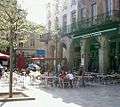Limoux
| Limoux | ||
|---|---|---|
 | ||
| ||
 Limoux | ||
|
Location within Occitanie region  Limoux | ||
| Coordinates: 43°03′28″N 2°13′09″E / 43.0578°N 2.2192°ECoordinates: 43°03′28″N 2°13′09″E / 43.0578°N 2.2192°E | ||
| Country | France | |
| Region | Occitanie | |
| Department | Aude | |
| Arrondissement | Limoux | |
| Canton | Limoux | |
| Government | ||
| • Mayor (2008–2014) | Jean-Paul Dupré (PS) | |
| Area1 | 32.41 km2 (12.51 sq mi) | |
| Population (2008)2 | 9,781 | |
| • Density | 300/km2 (780/sq mi) | |
| Time zone | CET (UTC+1) | |
| • Summer (DST) | CEST (UTC+2) | |
| INSEE/Postal code | 11206 / 11300 | |
| Elevation |
156–740 m (512–2,428 ft) (avg. 172 m or 564 ft) | |
|
1 French Land Register data, which excludes lakes, ponds, glaciers > 1 km² (0.386 sq mi or 247 acres) and river estuaries. 2 Population without double counting: residents of multiple communes (e.g., students and military personnel) only counted once. | ||
Limoux (French pronunciation: [limu]; Occitan: Limós [liˈmus]) is a commune and subprefecture in the Aude department, a part of the ancient Languedoc province and the present-day Occitanie region in southern France. It lies on the river Aude about 30 km (19 mi) due south of Carcassonne. Its vineyard is famous for being first to produce sparkling wine known as Blanquette de Limoux.
Blanquette de Limoux
Blanquette de Limoux is produced around the city of Limoux. The main grape of the wine is Mauzac, followed by Chardonnay and Chenin blanc. Wine historians believe that the world's first sparkling wine was produced in this region in 1531, by the monks at the abbey in Saint-Hilaire, Aude.[2]
Culture
The town is perhaps best known for its Winter festival called Fecas [ˈfekɔs], often referred to (inaccurately) as a Carnival or Fête. It is generally referred to as Carnaval de Limoux in French language.
Images
 Town square
Town square Carnival
Carnival
Sights
The heart of the town is the place de la République, a wide square with some fine stone arcading and a number of timber framed houses. Limoux straddles the River Aude and the banks are lined with grand houses, especially on the eastern side, the so-called Petite Ville (lit. "Small City").
The town likes to party in a most unself-conscious way and for its own pleasure rather than for the sake of tourists. While worth visiting in itself, it is also an excellent base for discovering the history of the region and is ideally placed for exploring the coast, the mountains and some of the finest walking country in France.
Markets
- Weekly market every Friday (or Thursday if a public holiday falls on a Friday).
- Flea market or Brocante the first Sunday of each month on the Promenade du Tivoli.
- Evening markets on Tuesdays in July and August.
Other sights
- The Musée Petiet (Tourist Information Office),
- Musée du Piano (Museum of the piano)
- CathaRama (a history of the Cathar movement).
- Winery tours at Sieur d'Arques and Aimery.
- Jardin aux Plantes la Bouichère - Flassian, 2 hectares of gardens which is home to various collections of increasingly rare plant varieties.
Personalities
Limoux was the birthplace of:
- Francis de Gaston, Chevalier de Levis (1719–1787), Marshal of France
- Alexandre Guiraud (1788–1847), poet, dramatic author and novelist
- Poulpard (1981-20**), one of the most famous French stand-up comedian, also writer of few dramatic novels.
See also
- Corbières Massif
- Limoux Grizzlies, a rugby league club from Limoux
- Limoux wine, white wine, usually sparkling, produced in the area
- Communes of the Aude department
Population
| Historical population | ||
|---|---|---|
| Year | Pop. | ±% |
| 1793 | 5,100 | — |
| 1800 | 5,142 | +0.8% |
| 1806 | 5,723 | +11.3% |
| 1821 | 5,915 | +3.4% |
| 1831 | 6,247 | +5.6% |
| 1836 | 7,105 | +13.7% |
| 1841 | 7,417 | +4.4% |
| 1846 | 7,444 | +0.4% |
| 1851 | 7,776 | +4.5% |
| 1856 | 6,835 | −12.1% |
| 1861 | 6,937 | +1.5% |
| 1866 | 6,770 | −2.4% |
| 1872 | 5,897 | −12.9% |
| 1876 | 6,661 | +13.0% |
| 1881 | 6,283 | −5.7% |
| 1886 | 6,810 | +8.4% |
| 1891 | 6,371 | −6.4% |
| 1896 | 6,684 | +4.9% |
| 1901 | 7,084 | +6.0% |
| 1906 | 7,223 | +2.0% |
| 1911 | 7,010 | −2.9% |
| 1921 | 6,640 | −5.3% |
| 1926 | 7,639 | +15.0% |
| 1931 | 7,797 | +2.1% |
| 1936 | 8,193 | +5.1% |
| 1946 | 7,587 | −7.4% |
| 1954 | 8,334 | +9.8% |
| 1962 | 9,603 | +15.2% |
| 1968 | 10,824 | +12.7% |
| 1975 | 11,101 | +2.6% |
| 1982 | 10,206 | −8.1% |
| 1990 | 9,665 | −5.3% |
| 1999 | 9,411 | −2.6% |
| 2008 | 9,781 | +3.9% |
References
External links
| Wikimedia Commons has media related to Limoux. |
- Photos of Limoux
- Aude in photos: Limoux (163 photos)
- Site de la Bande de Carnaval de Limoux ’Les Limouxins’
.svg.png)